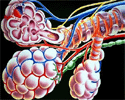With a $2 million grant from the National Institutes of Health (NIH), researchers from Rensselaer Polytechnic Institute are developing a physics-based virtual model that can simulate a patient’s breathing in real time.
When used in conjunction with existing 3D models, adding the fourth dimension of time could significantly improve the accuracy and effectiveness of radiation treatment for lung and liver cancers.
X. George Xu, professor of nuclear and biomedical engineering, and Suvranu De, associate professor of mechanical engineering, have formed a multidisciplinary collaboration with clinical colleagues at the Cancer Therapy & Research Center in San Antonio, Texas, to develop the 4D Visible Photographic Man (VIP-Man).
This virtual model is an extension of Xu’s ongoing project involving the 3D VIP-Man, which is an advanced computer model that simulates in 3D how radiation affects the organs and tissues in the human body.
‘Live patients are not static beings, and a moving organ such as the lung or heart is a main concern in radiation treatment or imaging of tumors that are affected by such organ movement,’ Xu said. ‘In order to determine accurate and effective radiation dosages, doctors must consider such issues as the breathing function and air volume change that are affected by several physiological factors over the course of the radiation treatment.’
Real-time simulations could allow doctors to spot the small fractions of time when the lungs, liver, kidneys, and eventually the heart, are stationary relative to the external radiation beams. These opportune moments during the actual therapy mean that doctors will have more confidence delivering the radiation to a moving tumour.
‘The 4-D VIP-Man will allow doctors and medical physicists to accurately predict and monitor these anatomical changes to provide the most effective treatment possible at any given time,’ Xu said.
The fourth dimension of the VIP-Man is not easily achieved, according to Xu. Currently Xu and De are focusing their energy on respiratory function. ‘Using advanced computational tools, it is possible to simulate lung movement; however, not in real time,’ De said. ‘For effective radiation therapy, physics-based real-time performance offers the ultimate solution.’

The key challenge in the project is to develop the algorithms that will make the virtual lungs and adjacent tissues move in real time according to realistic tissue biomechanical properties, De said.
Xu expects that the physics-based 4D VIP-Man will eventually be used as an even more general anatomical modelling tool for the biomedical community to help patients with respiratory and cardiac diseases. At the same time, Xu will continue to work on the 3D VIP-Man to create a ‘family’ of virtual patients, ranging in ages and sizes, in collaboration with researchers worldwide through the Consortium of Computational Human Phantoms (www.virtualphantoms.org), co-founded by Xu.




Glasgow trial explores AR cues for autonomous road safety
They've ploughed into a few vulnerable road users in the past. Making that less likely will make it spectacularly easy to stop the traffic for...